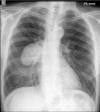Pulmonary blastoma: a case report and review of the literature
- PMID: 24885892
- PMCID: PMC4026592
- DOI: 10.1186/1756-0500-7-294
Pulmonary blastoma: a case report and review of the literature
Abstract
Background: Pulmonary blastomas are a rare aggressive neoplasm comprising 0.25-0.5% of all primary lung tumors and portend a poor prognosis. They display a biphasic histology with mesenchymal and epithelial components. Historically, the term pulmonary blastoma had included both pure fetal adenocarcinomas, pleuropulmonary blastomas as well as the classic biphasic blastomas. However recent World Health Organisation re-classifications separated well-differentiated fetal adenocarcinomas and pleuropulmonary blastomas from the biphasic tumours.
Case presentation: We present a case of a systemically well 67-year-old Caucasian male who presented with haemoptysis. Investigations confirmed the presence of a large right-sided lung mass and biopsy identified non-small cell carcinoma. The resected tumour was markedly necrotic revealing a biphasic pattern. It was composed of malignant glandular tissue with sub-nuclear vacuoles, associated with a pleomorphic stromal malignant blastematous component, characteristic of classic biphasic pulmonary blastoma.
Conclusion: We present a case of a classic biphasic pulmonary blastoma, a rare lung cancer occurring at an earlier age and portending to poorer prognosis than other more common lung cancers. Given the small number of cases and recent re-classification, interpreting the published epidemiology and clinical features of this disease is difficult. Many earlier reports may have included fetal adenocarcinomas (in particular high grade variant), which need to be considered when discussing treatment and prognosis with newly-diagnosed patients. Much could be gained from a central registry of individual experiences to improve our understanding of this rare lung cancer.
Figures



Similar articles
-
The Radiologic and Pathologic Diagnosis of Biphasic Pulmonary Blastoma.J Radiol Case Rep. 2017 Sep 30;11(9):10-21. doi: 10.3941/jrcr.v11i9.3153. eCollection 2017 Sep. J Radiol Case Rep. 2017. PMID: 29299105 Free PMC article.
-
Classic biphasic pulmonary blastoma: a case report and review of the literature.Lung Cancer. 2011 Aug;73(2):127-32. doi: 10.1016/j.lungcan.2011.03.018. Epub 2011 Apr 21. Lung Cancer. 2011. PMID: 21513998 Review.
-
Survival of biphasic pulmonary blastoma.Respir Med. 2006 Jul;100(7):1174-9. doi: 10.1016/j.rmed.2005.10.026. Epub 2005 Dec 5. Respir Med. 2006. PMID: 16332433
-
Classic biphasic pulmonary blastoma (CBPB): a rare primary pulmonary malignancy.BMJ Case Rep. 2021 Aug 10;14(8):e244151. doi: 10.1136/bcr-2021-244151. BMJ Case Rep. 2021. PMID: 34376421 Free PMC article.
-
Pleuropulmonary blastoma is THE pulmonary blastoma of childhood.Semin Diagn Pathol. 1994 May;11(2):144-51. Semin Diagn Pathol. 1994. PMID: 7809508 Review.
Cited by
-
Classic biphasic pulmonary blastoma: a case report and review of the literature.J Int Med Res. 2020 Oct;48(10):300060520962394. doi: 10.1177/0300060520962394. J Int Med Res. 2020. PMID: 33107372 Free PMC article. Review.
-
Real Time F-18 FDG PET-CT-Guided Metabolic Biopsy Targeting Differential FDG Avidity in a Pulmonary Blastoma.Nucl Med Mol Imaging. 2020 Oct;54(5):261-263. doi: 10.1007/s13139-020-00655-6. Epub 2020 Jul 20. Nucl Med Mol Imaging. 2020. PMID: 33088357 Free PMC article.
-
What do we know about pulmonary blastoma?: review of literature and clinical case report.Nagoya J Med Sci. 2016 Dec;78(4):507-516. doi: 10.18999/nagjms.78.4.507. Nagoya J Med Sci. 2016. PMID: 28008207 Free PMC article.
-
Pulmonary blastoma in a pregnant woman: a case report and brief review of the literature.BMC Pulm Med. 2022 Jan 4;22(1):8. doi: 10.1186/s12890-021-01804-z. BMC Pulm Med. 2022. PMID: 34983474 Free PMC article. Review.
-
Classic biphasic pulmonary blastoma: A case report and review of the literature from 2000 to 2022.Clin Respir J. 2023 Nov;17(11):1103-1116. doi: 10.1111/crj.13701. Epub 2023 Sep 29. Clin Respir J. 2023. PMID: 37772674 Free PMC article. Review.
References
-
- Fung CH, Lo JW, Yonan TN, Milloy FJ, Hakami MM, Changus GW. Pulmonary blastoma. An ultrastructural study with a brief review of literature and a discussion of pathogenesis. Cancer. 1997;39:153–163. - PubMed
-
- Travis WD, Colby TV, Corrin B, Shimosato Y, Brambilla E. Collaboration with Sobin LH and Pathologists from 14 Countries. World Health Organization International Histological Classification of Tumours. 3. Verlag: Springer; 1999. Histological Typing of Lung and Pleural Tumours.
-
- Travis WD, Brambilla E, Muller-Hermlink HK, Harris. In: World Health Organization Classification of Tumours. CC, editor. Lyon: IARC Press; 2004. Pathology and genetics of tumours of the lung, pleura, thymus and heart.
Publication types
MeSH terms
LinkOut - more resources
Full Text Sources
Other Literature Sources

